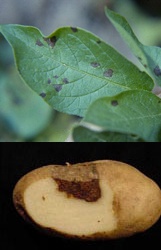Diseases
Alternaria solani Sor. - Early Blight of Potato
Systematic position.
Section Deuteromycota, order Hyphales, family Dematiaceae, genus Alternaria.Synonym.
Macrosporium solani Ell. et Mart.Biological group.
Facultative parasite.Morphology and biology.
Leaves, stems, and tubers are affected by this pathogen. Initial infection is most frequent on older leaves. Spots are dark brown, having concentric rings. The spots develop mainly in the center of leaves. During the period of potato vegetation the disease progresses and infected leaves turn yellow and dry or fall. On stems the spots are gaunt, having no clear contours. During potato harvest the fungus spores can be transferred to tubers from infected leaves and tops, but the tuber infection is usually evident only several months later after potato storage. Dry, dark and pressed into tubers, the lesions appear on the tuber surface. The underlying flesh is dry, leathery, and usually brown. Lesions can enlarge during storage, and tubers can become shriveled. Mycelium, conidia, and chlamidospores winter in soil or in dead leaves and infected tops. If spring weather is moist and warm, the fungus begins to produce spores actively and infects potato. A. solani produces large (15-19 x 150-300 microns) pear-shaped conidia with both transverse and longitudinal cross walls. The multi-cellular conidia vary in color from pale to light tan. Conidiophores occur singly or in small groups; they are pale to olive-brown. Spores are carried primarily by wind, infecting potato leaves under conditions of warm weather and high relative humidity (95%).Distribution.
The disease is spread everywhere throughout the zones of potato cultivation. Every year this disease is found in Volga-Vyatka, Central and Central Black Soil areas, and in the Far East. Early Blight has a very high severity in Baikal zone, in the Far East and in North East region of the European part of Russia; a moderate development of the disease is observed in Central Russia.Ecology.
In addition to the potato, A. solani can infect tomato. Warm weather, with short rains or abundant dews, is favorable for the development of the disease. Optimum temperature for the conidia germination is 24-30 degrees C, minimum is 7 degrees C; optimum humidity is 90-100%. Late cultivars are usually more resistant than early ones. Early Blight is often more prevalent on older tissues and on the leaves damaged by insects. The disease is more severe when the potato plants are under stress, having been injured or having poor nutrition.Economic significance.
The disease decreases the germination of sowing material and tuber yield, causes premature dying of tops, and diminishes the quality of tubers during storage. During years of epidemics 75% of tops of early varieties are infected with A. solani, and the tuber yield decreases by more than 40%. Tuber storage length and germinating power also decreases. To protect the potato from the disease, the following measures are recommended: removal of infected tubers during storage; crop rotation with the use of cereals as precursors; spatial isolation of potato and tomato sowings; the use of resistant cultivars. Before appearance of the first disease symptoms the potato plants should be sprayed by fungicides. The first treatment is a preventive (prophylactic) one, when the conditions are favorable for disease development, but before the tops begin to close in plant rows. The next treatments must be applied in 10-14 days. It is necessary to remove or plow crop residues.Reference citations:
Kvasnyuk N.Y., Kozlovskii B.E. 1985. Early Blight of Potato. Zashchita rastenii, 11: 27-28. (In Russian)Levkina L.M. 2003. Genus Alternaria Nees. News in systematics and nomenclature of fungi. Moscow: National Academy of Mycology. 276-303 p. (In Russian)
Volovik A.S., Kladova A.I. 1969. Fungal diseases of potato. Distribution of pests and diseases of agricultural plants in Russia in 1968 and forecast of their appearance in 1969. Moscow: Rosselkhozizdat. 126-129 p. (In Russian)
Volovik A.S., Litun B.P. 1975. Damage of potato diseases. Zashchita rastenii, 7: 4-5. (In Russian)
Yagneshko D.I. 2000. Early Blight of Potato. Achova Raslin, 3: 21-22. (In Russian)
© Levitin M.M.


